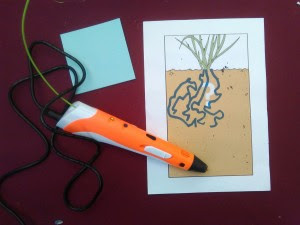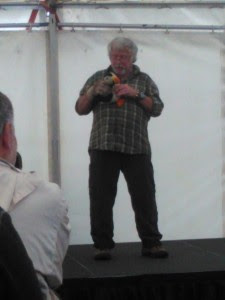Seed lucky dips, 3D-printer pens, and Bill Oddie with a puffin. All in a day’s volunteering for the Festival of Nature 2015!
Bristol’s Festival of Nature is the UK’s largest celebration of the natural world, and has recently spread over into Bath too. This year, I helped Kevin Smyth and Tom Denbigh from the School of Biological Sciences. Their work in Prof Claire Grierson's lab group looks at plant roots, especially how important they are at preventing soil erosion. This work is funded by the Leverhulme Trust.
We also had some smaller plants growing in transparent media (see image above). The bean on the left has thicker roots and very few side shoots, whereas the tomato on the right has much thinner roots but more side shoots.
If you want evidence that plants do help combat soil erosion, just look at the pictures! Soil without plants (right) can be really crumbly and doesn't hold itself together well. A slight slope and some rainfall would wash it away easily, leading to soil erosion. Soil and plants is a far more effective solution, holding itself together with ease – even without a supporting pot. One of so many reasons why we need more plants around!
 |
| Seed lucky dip at the Festival of Nature. |
In the lab, Kevin’s group studies roots to try and understand why plants are so effective at preventing soil erosion. To do this, they can make mutations in some plants and see if it changes the roots. The mutant plants of choice are Arabadopsis, weedy relatives of the mustard plant and perhaps the most studied plant in the world.
Looking down the microscope at the samples, you could work out which plant was the “bald” mutant (below left) and which was the “werewolf” (below right) compared to the normal roots in the middle. If we understand how the plant’s genetics affects their roots, perhaps in the future we could grow plants that are better at holding the soil together.
 |
| Looking down the microscope at the samples, you could work out which plant was the “bald” mutant (left) and which was the “werewolf” (right) compared to the normal roots in the middle. |
 |
| A 3D printing pen was used to create root structures at the Festival of Nature. |
As a bonus, my lunch break timed nicely with Bill Oddie’s talk so I got to hear him tell a bunch of amusing anecdotes about his young life and how that led to a passion for wildlife. One of these apparently required a stuffed puffin!
 |
| Bill Oddie at the Festival of Nature. |
--------------------------------------
This blog is written by Emily Coyte, and has been reproduced from her blog Memetic Drift. Emily is an Assistant Teacher in the School of Biochemistry at the University of Bristol.
 |
| Emily Coyte |



